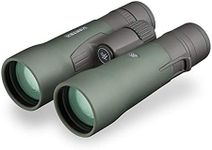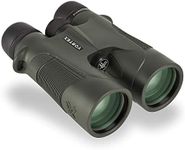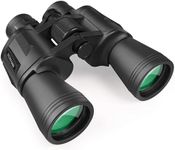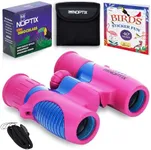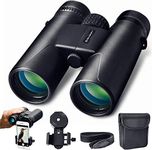Buying Guide for the Best 10 X 50 Binoculars
Choosing the right pair of 10x50 binoculars can greatly enhance your viewing experience, whether you're bird watching, stargazing, or attending a sports event. The key is to understand the specifications and how they align with your needs. Here are the main specs to consider and how to navigate them to find the best fit for you.MagnificationMagnification refers to how much closer an object appears through the binoculars compared to the naked eye. In 10x50 binoculars, the '10x' means the object will appear ten times closer. Higher magnification can provide more detail but may also make the image shakier and reduce the field of view. For general use, 10x is a good balance between detail and stability. If you need more stability, consider lower magnification, but if you need more detail and can handle a steadier hand or use a tripod, higher magnification might be better.
Objective Lens DiameterThe objective lens diameter is the second number in the specification, in this case, '50'. It measures the diameter of the front lenses in millimeters. Larger diameters allow more light to enter, which can provide a brighter image, especially in low-light conditions. A 50mm lens is quite large and suitable for activities like stargazing or wildlife observation at dawn or dusk. If you need a more compact and lightweight option, you might consider binoculars with a smaller objective lens diameter.
Field of ViewField of view (FOV) is the width of the area you can see through the binoculars at a certain distance, usually measured in feet at 1,000 yards or meters at 1,000 meters. A wider FOV allows you to see more of the scene without moving the binoculars, which is useful for tracking moving objects like birds or sports players. If you need to observe a wide area, look for binoculars with a larger FOV. For detailed observation of a specific point, a narrower FOV might be sufficient.
Eye ReliefEye relief is the distance from the eyepiece to your eye where you can still see the full field of view. This is particularly important for eyeglass wearers. Longer eye relief allows you to hold the binoculars further from your eyes, which can be more comfortable and provide a full view even with glasses on. If you wear glasses, look for binoculars with an eye relief of at least 15mm. If you don't wear glasses, shorter eye relief might be acceptable.
Weight and SizeThe weight and size of binoculars can affect how comfortable they are to use and carry. Heavier binoculars can be more stable but may cause fatigue if used for extended periods. Lighter binoculars are easier to carry and handle but might be less stable. Consider how you plan to use the binoculars: for long hikes or travel, lighter models might be preferable, while for stationary use, weight might be less of an issue.
Prism TypeBinoculars use prisms to correct the orientation of the image. There are two main types: Porro prisms and roof prisms. Porro prism binoculars tend to be bulkier but can offer better depth perception and a wider field of view. Roof prism binoculars are more compact and durable but can be more expensive. Choose Porro prisms for better image quality and depth, and roof prisms for portability and ruggedness.
CoatingsLens coatings improve light transmission, reduce glare, and enhance image quality. There are different levels of coatings: coated, fully coated, multi-coated, and fully multi-coated. Fully multi-coated lenses provide the best performance with the brightest and clearest images. If you need the best possible image quality, look for fully multi-coated lenses. For casual use, lower levels of coating might be sufficient.

